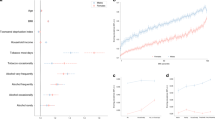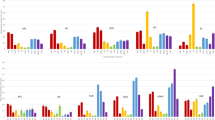Abstract
To investigate possible modes of inheritance that would explain familial aggregation in obstructive sleep apnea (OSA), familial correlation and segregation analyses were performed on data derived from 584 pedigrees with 2019 cases enrolled in the Tucson Epidemiologic Study of Obstructive Airways Disease (TESOAD) who were at least 10 years of age and who had information pertaining to snoring and daytime sleepiness. Data were obtained from the 9th (May 1984 to October 1985) and 12th (February 1990 to October 1992) surveys of the TESOAD, which is a random, stratified sample of the non-Hispanic Caucasian population of Tucson, Arizona. A snoring phenotype was considered present if it occurred on at least some nights. A “sleep apnea” phenotype was constructed if participants snored and experienced daytime sleepiness. Familial correlations for snoring showed significant mother-child and sibling correlations but not father-child correlations. For sleep apnea, significant parent-daughter but not parent-son or sibling correlations were observed. Segregation analyses for snoring with regressive familial effects and sibling, age, and obesity covariates showed no evidence for mendelian transmission. However, additional familial effects were present that suggested phenotype aggregation from polygenic or environmental factors, or both. For the sleep apnea phenotype, similar segregation analyses indicated that mendelian dominant or codominant models were possible. However, the analyses also suggested that a nongenetic model fit the data as well. In addition, consistent with the familial correlations, specific maternal- and sibling-related effects remained even after inclusion of age, gender, and obesity covariates. These data support the concept that inheritable or shared environmental factors contribute to the development of OSA and that maternal components may be more important than paternal ones.
Similar content being viewed by others
References
Orr WH, Quan SF. Sleep Apnea Syndromes—A Primer of Diagnosis and Treatment, Chanhassen, MN: CNS. Inc., 1991.
Gislason T, Aberg H, Taube A. Snoring and systemic hypertension—an epidemiologic study. Acta Med Scand 1987;222:415–421
Hung J, Whitford EG, Parsons RW et al. Association of sleep apnoea with myocardial infarction in men. Lancet 1990;336:261–264
Malone S, Liu PP, Holloway R, Rutherford R, Zie A, Bradley TD. Obstructive sleep apnoea in patients with dilated cardiomyopathy—effects of continuous positive airway pressure. Lancet 1991;338:1480–1484
Palomaki H. Snoring and the risk of ischemic brain infarction. Stroke 1991;22:1021–1025
Partinen M, Guilleminault C. Daytime sleepiness and vascular morbidity at seven-year follow-up in obstructive sleep apnea patients. Chest 1988;94:9–24
Findley LJ, Unverzagt ME, Suratt P. Automobile accidents involving patients with obstructive sleep apnea. Am Rev Respir Dis 1988;138:337–340
Young T, Palta M, Dempsey J, et al. The occurrence of sleep-disordered breathing among middle-aged adults. N Engl J Med 1993;328:1230–1235
Guilleminault C, Partinen M, Hollman K, Powell N, Stoohs R. Familial aggregates in obstructive sleep apnea syndrome. Chest 1995;107:1545–1551
El Bayadi S, Millman RP, Tishler PV et al. A family study of sleep apnea—anatomic and physiologic interactions. Chest 1990;98:554–559
Mathur R, Douglas NJ. Family studies in patients with the sleep apnea-hypopnea syndrome. Ann Intern Med 1995;122:174–178
Wittig RM, Zorick FJ, Roehrs TA, Sicklesteel JM, Roth TM. Familial childhood sleep apnea. Henry Ford Hosp Med J 1988;36:13–15
Pillar G, Lavie P. Assessment of the role of inheritance in sleep apnea syndrome. Am J Respir Crit Care Med 1995;151:688–691
Strohl KP, Saunders NA, Feldman NT, Hallet M. Obstructive sleep apnea in family members. N Engl J Med 1978;299:969–973
Manon-Espillat R, Goethe B, Adams N, Newman C, Ruf R. Familial ‘sleep apnea plus’ syndrome: Report of a family. Neurology 1988;38:190–193
Douglas NJ, Luke M, Mathus R. Is the sleep apnoea/hypopnea syndrome inherited?. Thorax 1993;48:719–721
Redline S, Tishler PV, Tosteson TD et al. The familial aggregation of obstructive sleep apnea. Am J Respir Crit Care Med 1995;151:682–687
Carmelli D, Swan GE, Bliwise DL et al. Prevalence and concordance rates for sleep disordered breathing (SDB) in adult male twins: The National Heart, Lung, and Blood Institute Twin Study. Sleep Res 1997;26:340–340
Ferini-Strambi L, Calori G, Oldani A, et al. Snoring in twins. Respir Med 1995;89:337–340
Elston RC. Segregation analysis. In: Harris H, Hirschhorn K, eds. Advances in Human Genetics, vol. 2. New York: Plenum,; 1980:83–120
Lebowitz MD, Knudson RJ, Burrows B. Tucson epidemiologic study of obstructive lung disease. I. Methodology and prevalence of disease. Am J Epidemiol 1975;102:137–152
Bloom JW, Kaltenborn WT, Quan SF. Risk factors in a general population for snoring. Chest 1988;93:678–683
Dodge R, Cline MG, Quan SF. The natural history of insomnia and its relationship to respiratory symptoms. Arch Intern Med 1995;155:1797–1800
Bliwise DL, Nekich JC, Dement WC. Relative validity of self-reported snoring as a symptom of sleep apnea in a sleep clinic population. Chest 1991;99:600–608
Redline S, Toteson T, Tishler PV, Carskadon MA, Millman RP. Studies in the genetics of obstructive sleep apnea—familial aggregation of symptoms associated with sleep-related breathing disturbances. Am Rev Respir Dis 1992;145:440–444
Marcus CL. Clinical and pathophysiological aspects of obstructive sleep apnea in children. Pediatr Pulmonol 1997;16(suppl):123–124
Revicki DA, Israel RG. Relationship between body mass indices and measures of body adiposity. Am J Public Health 1986;76:992–994
S.A.G.E. 1997. Statistical Analysis for Genetic Epidemiology. Release 3.1. Computer program package available from the Department of Epidemiology and Biostatistics, Rammelkamp Center for Education and Research, Metro Health Campus, Case Western Reserve University, Cleveland, OH
Bonney GE. Regressive logistic models for familial disease and other binary traits. Biometrics 1986;42:611–625
Go RCP, Elston RC, Kaplan EB. Efficiency and robustness of pedigree segregation analysis. Am J Hum Genet 1978;30:28–37
Cannings C, Thompson EA, Skolnick MH. Probability functions on complex pedigrees. Adv Appl Prob 1978;10:26–61
Demenais FM, Laing AE, Bonney GE. Numerical comparisons of two formulations of the logistic regression models with the mixed model in segregation analyses of discrete traits. Genet Epidemiol 1992;9:419–435
Karunaratne PM, Elston RC, Loman N, Olsson H, Ranstam J. Analysis of Swedish male breast cancer family data: A simple way to incorporate a common sibling effect. Genet Epidemiol 1998;15:201–212
Holberg CJ, Morgan WJ, Wright AL, Martinez FD. Differences in familial segregation of FEV1 between asthmatic and nonasthmatic families: Role of a maternal component. Am J Respir Crit Care Med 1998;158:162–169
Holberg CJ, Elston RC, Halonen M, et al. Segregation analysis of physician diagnosed asthma in Hispanic and non-Hispanic white families: a recessive component? Am J Respir Crit Care Med 1996;154:144–150.
Martinez FD, Holberg CJ, Halonen M, et al. Evidence for mendelian inheritance of serum IgE levels in Hispanic and non-Hispanic white families. Am J Hum Genet 1994;55:555–565
Jones RH. Longitudinal Data with Serial Correlation: A State Space Approach. London: Chapman and Hill, 1993.
Wetter DW, Young TB, Bidwell TR, Badr MS, Palta M. Smoking as a risk factor for sleep-disordered breathing. Arch Intern Med 1994;154:2219–2224
Kushida CA, Guilleminault C, Mignot E, et al. Genetic and craniofacial dysmorphism in family studies of obstructive sleep apnea. Sleep Res 1996;25:275–275
Redline S, Tishler PV, Hans MG et al. Racial differences in sleep-disordered breathing in African-Americans and Caucasians. Am J Respir Crit Care Med 1997;155:186–192
Yoshizawa T, Akashiba T, Kurashima K, Otsuka K, Horie T. Genetics and obstructive sleep apnea syndrome: A study of human leukocyte antigen (HLA) typing. Intern Med 1993;32:94–97
Redline S, Leithner J, Arnold J, Tishler PV, Altose MD. Ventilatory-control abnormalities in familial sleep apnea. Am J Respir Crit Care Med 1997;156:155–160
Burns TL, Moll PP, Lauer RM. Genetic models of human obesity—family studies. Crit Rev Food Sci Nutr 1993;33:339–343
Palta M, Prineas RJ, Berman R, Hannan P. Comparison of self-reported and measured height and weight. Am J Epidemiol 1982;115:223–230.
Kapuniai LE, Andrew DJ, Crowell DH, Pearce JW. Identifying sleep apnea from self reports. Sleep 1988;11:43–436
Lindberg E, Janson C, Svardsudd K, et al. Increased mortality among sleep snorers: A prospective population based study. Thorax 1998;53:627–628
Author information
Authors and Affiliations
Corresponding author
Rights and permissions
About this article
Cite this article
Holberg, C.J., Natrajan, S., Cline, M.G. et al. Familial Aggregation and Segregation Analysis of Snoring and Symptoms of Obstructive Sleep Apnea. Sleep Breath 4, 23–31 (2000). https://doi.org/10.1007/s11325-000-0023-z
Issue Date:
DOI: https://doi.org/10.1007/s11325-000-0023-z




